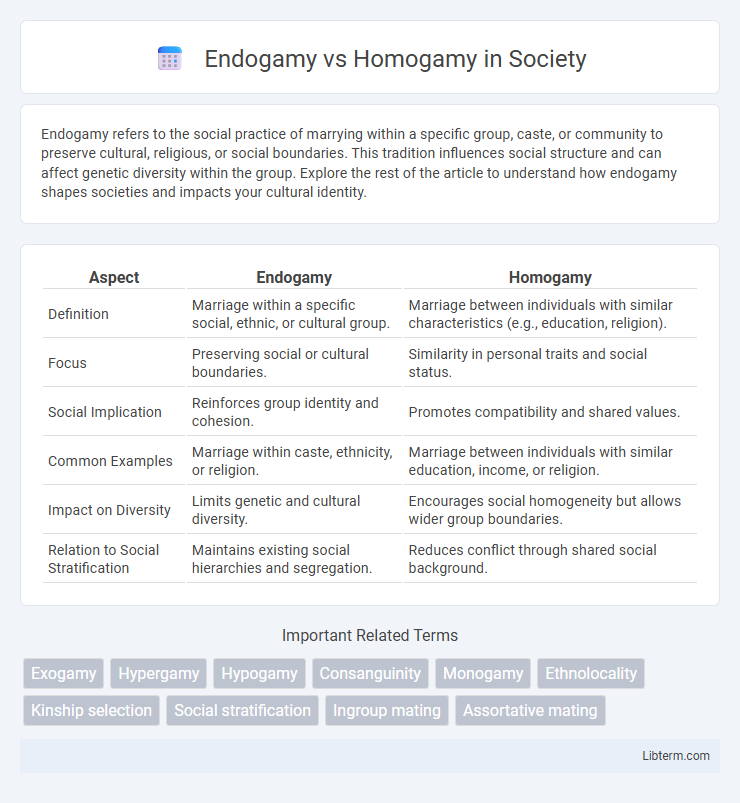Endogamy refers to the social practice of marrying within a specific group, caste, or community to preserve cultural, religious, or social boundaries. This tradition influences social structure and can affect genetic diversity within the group. Explore the rest of the article to understand how endogamy shapes societies and impacts your cultural identity.
Table of Comparison
| Aspect | Endogamy | Homogamy |
|---|---|---|
| Definition | Marriage within a specific social, ethnic, or cultural group. | Marriage between individuals with similar characteristics (e.g., education, religion). |
| Focus | Preserving social or cultural boundaries. | Similarity in personal traits and social status. |
| Social Implication | Reinforces group identity and cohesion. | Promotes compatibility and shared values. |
| Common Examples | Marriage within caste, ethnicity, or religion. | Marriage between individuals with similar education, income, or religion. |
| Impact on Diversity | Limits genetic and cultural diversity. | Encourages social homogeneity but allows wider group boundaries. |
| Relation to Social Stratification | Maintains existing social hierarchies and segregation. | Reduces conflict through shared social background. |
Introduction to Endogamy and Homogamy
Endogamy refers to the social practice of marrying within a specific group, caste, or ethnicity to preserve cultural or social boundaries. Homogamy involves marriage between individuals with similar characteristics such as socioeconomic status, education, or religion, enhancing social compatibility and stability. Both endogamy and homogamy influence social structures by reinforcing group identity and cohesion.
Defining Endogamy: Meaning and Origins
Endogamy refers to the social practice of marrying within a specific group, caste, or community, preserving cultural, religious, or ethnic boundaries. Originating from anthropological studies, endogamy has been fundamental in maintaining social cohesion and inherited traits within groups. This practice contrasts with homogamy, which emphasizes marrying individuals with similar socioeconomic, educational, or demographic characteristics regardless of group boundaries.
Understanding Homogamy: Key Concepts
Homogamy refers to the practice of individuals marrying or forming partnerships with others who share similar characteristics such as socioeconomic status, education level, religion, or ethnicity. This social phenomenon promotes cultural cohesion and reduces conflict by ensuring compatibility and shared values among partners. Research indicates that homogamous unions often experience higher levels of stability and satisfaction due to aligned interests and mutual understanding.
Historical Contexts of Endogamy and Homogamy
Endogamy, historically rooted in preserving social, religious, or ethnic group boundaries, often served to maintain power structures and cultural integrity within caste systems, royal lineages, or ethnic communities. Homogamy emerged with increasing social stratification and urbanization, reflecting a preference for partners within similar socioeconomic, educational, or cultural backgrounds to sustain social cohesion and economic stability. Both practices are deeply embedded in historical contexts where marriage functions as a tool for reinforcing identity, hierarchy, and community continuity.
Cultural Significance and Social Impact
Endogamy, the practice of marrying within a specific cultural, ethnic, or social group, reinforces cultural identity and social cohesion by preserving traditions and values. Homogamy, the tendency to choose partners with similar socioeconomic status, education, or religion, promotes social stability and reduces cultural conflict by aligning lifestyles and beliefs. Both practices shape social structures, influencing patterns of social mobility and group boundaries within societies.
Endogamy vs Homogamy: Major Differences
Endogamy refers to the practice of marrying within a specific social group, caste, or community to maintain cultural or social integrity, while homogamy involves choosing partners with similar socioeconomic backgrounds, education, or values, regardless of group boundaries. The major difference lies in endogamy's emphasis on strict group boundaries and preservation of identity, whereas homogamy prioritizes compatibility based on shared traits and lifestyles. Endogamous unions reinforce social cohesion within groups, whereas homogamous marriages reflect social similarity and personal preference across or within groups.
Pros and Cons of Endogamous Marriages
Endogamous marriages, where partners marry within a specific social group, caste, or community, often strengthen cultural continuity and preserve shared values and traditions. However, these unions may limit genetic diversity, increasing the risk of inherited health issues and potentially reducing adaptive social exposure. While endogamy fosters group cohesion and supports social stability, it can also constrain personal choice and limit opportunities for broader social integration.
Advantages and Disadvantages of Homogamous Unions
Homogamous unions, characterized by partners sharing similar social, cultural, or economic backgrounds, often benefit from greater mutual understanding and reduced conflict due to shared values and lifestyles. These unions can enhance social cohesion and stability within communities but may limit exposure to diverse perspectives and reduce genetic diversity. The disadvantages include potential social isolation and perpetuation of homogeneous social networks that hinder broader social integration.
Modern Trends: Changing Patterns in Marriage
Modern trends reveal a shift from traditional endogamy, where marriage occurs within a specific social group, towards increased homogamy, characterized by partners sharing similar socio-economic backgrounds or education levels. Growing globalization and social mobility contribute to this pattern, as couples increasingly prioritize common values and lifestyle compatibility over strict cultural or kinship boundaries. Digital matchmaking platforms further enable homogamous relationships by connecting individuals with aligned interests and social statuses.
Conclusion: The Future of Partner Selection
Endogamy, the practice of marrying within a specific social group or community, faces challenges as global connectivity and cultural exchange increase, promoting more diverse partner choices. Homogamy, the tendency to select partners with similar socioeconomic, educational, or cultural backgrounds, remains significant due to shared values and increased social stability. Future partner selection will likely balance traditional endogamous preferences with expanding homogamous trends influenced by globalization, digital communication, and evolving social norms.
Endogamy Infographic

 libterm.com
libterm.com